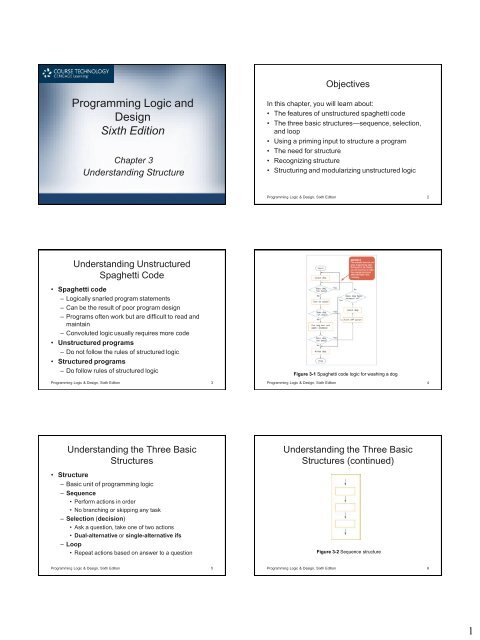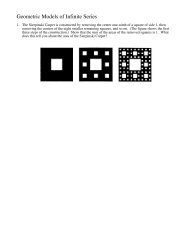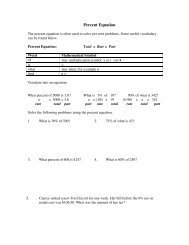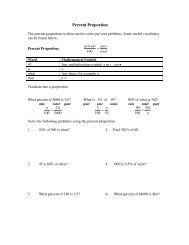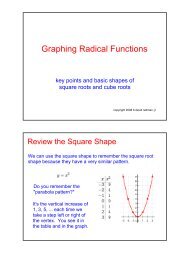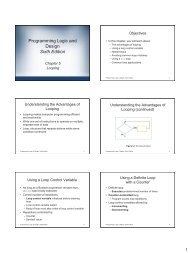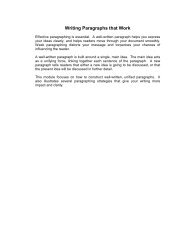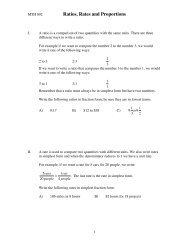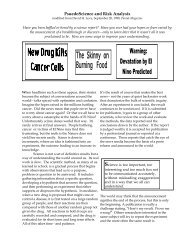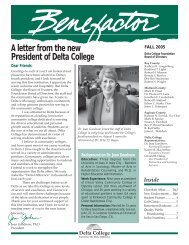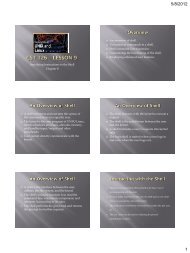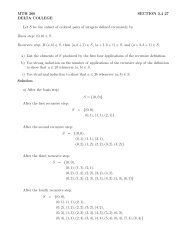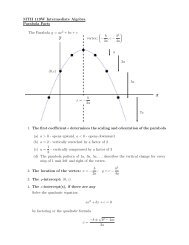Programming Logic and Design Sixth Edition
Programming Logic and Design Sixth Edition
Programming Logic and Design Sixth Edition
You also want an ePaper? Increase the reach of your titles
YUMPU automatically turns print PDFs into web optimized ePapers that Google loves.
<strong>Programming</strong> <strong>Logic</strong> <strong>and</strong><br />
<strong>Design</strong><br />
<strong>Sixth</strong> <strong>Edition</strong><br />
Chapter 3<br />
Underst<strong>and</strong>ing Structure<br />
Objectives<br />
In this chapter, you will learn about:<br />
• The features of unstructured spaghetti code<br />
• The three basic structures—sequence, selection,<br />
<strong>and</strong> loop<br />
• Using a priming input to structure a program<br />
• The need for structure<br />
• Recognizing structure<br />
• Structuring <strong>and</strong> modularizing unstructured logic<br />
<strong>Programming</strong> <strong>Logic</strong> & <strong>Design</strong>, <strong>Sixth</strong> <strong>Edition</strong> 2<br />
Underst<strong>and</strong>ing Unstructured<br />
Spaghetti Code<br />
• Spaghetti code<br />
– <strong>Logic</strong>ally snarled program statements<br />
– Can be the result of poor program design<br />
– Programs often work but are difficult to read <strong>and</strong><br />
maintain<br />
– Convoluted logic usually requires more code<br />
• Unstructured programs<br />
– Do not follow the rules of structured logic<br />
• Structured programs<br />
– Do follow rules of structured logic<br />
Figure 3-1 Spaghetti code logic for washing a dog<br />
<strong>Programming</strong> <strong>Logic</strong> & <strong>Design</strong>, <strong>Sixth</strong> <strong>Edition</strong> 3 <strong>Programming</strong> <strong>Logic</strong> & <strong>Design</strong>, <strong>Sixth</strong> <strong>Edition</strong> 4<br />
Underst<strong>and</strong>ing the Three Basic<br />
Structures<br />
• Structure<br />
– Basic unit of programming logic<br />
– Sequence<br />
• Perform actions in order<br />
• No branching or skipping any task<br />
– Selection (decision)<br />
• Ask a question, take one of two actions<br />
• Dual-alternative or single-alternative ifs<br />
– Loop<br />
• Repeat actions based on answer to a question<br />
Underst<strong>and</strong>ing the Three Basic<br />
Structures (continued)<br />
Figure 3-2 Sequence structure<br />
<strong>Programming</strong> <strong>Logic</strong> & <strong>Design</strong>, <strong>Sixth</strong> <strong>Edition</strong> 5 <strong>Programming</strong> <strong>Logic</strong> & <strong>Design</strong>, <strong>Sixth</strong> <strong>Edition</strong> 6<br />
1
Underst<strong>and</strong>ing the Three Basic<br />
Structures (continued)<br />
Underst<strong>and</strong>ing the Three Basic<br />
Structures (continued)<br />
• Dual-alternative if<br />
– Contains two alternatives<br />
– If-then-else structure<br />
if someCondition is true then<br />
else<br />
do oneProcess<br />
do theOtherProcess<br />
Figure 3-3 Selection structure<br />
<strong>Programming</strong> <strong>Logic</strong> & <strong>Design</strong>, <strong>Sixth</strong> <strong>Edition</strong> 7<br />
<strong>Programming</strong> <strong>Logic</strong> & <strong>Design</strong>, <strong>Sixth</strong> <strong>Edition</strong> 8<br />
Underst<strong>and</strong>ing the Three Basic<br />
Structures (continued)<br />
Underst<strong>and</strong>ing the Three Basic<br />
Structures (continued)<br />
• Single-alternative if<br />
if employee belongs to dentalPlan then<br />
deduct $40 from employeeGrossPay<br />
– Else clause is not required<br />
• null case<br />
– Situation where nothing is done<br />
Figure 3-4 Single-alternative selection structure<br />
<strong>Programming</strong> <strong>Logic</strong> & <strong>Design</strong>, <strong>Sixth</strong> <strong>Edition</strong> 9<br />
<strong>Programming</strong> <strong>Logic</strong> & <strong>Design</strong>, <strong>Sixth</strong> <strong>Edition</strong> 10<br />
Underst<strong>and</strong>ing the Three Basic<br />
Structures (continued)<br />
• Loop structure<br />
– Repeats a set of actions based on the answer to a<br />
question<br />
• Loop body<br />
– Also called repetition or iteration<br />
– Question is asked first in the most common form of<br />
loop<br />
– while … do or while loop<br />
Underst<strong>and</strong>ing the Three Basic<br />
Structures (continued)<br />
Figure 3-5 Loop structure<br />
<strong>Programming</strong> <strong>Logic</strong> & <strong>Design</strong>, <strong>Sixth</strong> <strong>Edition</strong> 11<br />
<strong>Programming</strong> <strong>Logic</strong> & <strong>Design</strong>, <strong>Sixth</strong> <strong>Edition</strong> 12<br />
2
Underst<strong>and</strong>ing the Three Basic<br />
Structures (continued)<br />
• Loop structure<br />
while testCondition continues to be true<br />
do someProcess<br />
while quantityInInventory remains low<br />
continue to orderItems<br />
<strong>Programming</strong> <strong>Logic</strong> & <strong>Design</strong>, <strong>Sixth</strong> <strong>Edition</strong> 13<br />
Underst<strong>and</strong>ing the Three Basic<br />
Structures (continued)<br />
• All logic problems can be solved using only these<br />
three structures<br />
• Structures can be combined in an infinite number<br />
of ways<br />
• Stacking<br />
– Attaching structures end-to-end<br />
• End-structure statements<br />
– Indicate the end of a structure<br />
– The endif statement ends an if-then-else structure<br />
– The endwhile ends a loop structure<br />
<strong>Programming</strong> <strong>Logic</strong> & <strong>Design</strong>, <strong>Sixth</strong> <strong>Edition</strong> 14<br />
Underst<strong>and</strong>ing the Three Basic<br />
Structures (continued)<br />
Underst<strong>and</strong>ing the Three Basic<br />
Structures (continued)<br />
• Any individual task or step in a structure can be<br />
replaced by a structure<br />
• Nesting<br />
– Placing one structure within another<br />
– Indent the nested structure’s statements<br />
• Block<br />
– Group of statements that execute as a single unit<br />
Figure 3-6 Structured flowchart <strong>and</strong> pseudocode with three stacked structures<br />
<strong>Programming</strong> <strong>Logic</strong> & <strong>Design</strong>, <strong>Sixth</strong> <strong>Edition</strong> 15<br />
<strong>Programming</strong> <strong>Logic</strong> & <strong>Design</strong>, <strong>Sixth</strong> <strong>Edition</strong> 16<br />
Underst<strong>and</strong>ing the Three Basic<br />
Structures (continued)<br />
Underst<strong>and</strong>ing the Three Basic<br />
Structures (continued)<br />
Figure 3-7 Flowchart <strong>and</strong> pseudocode showing nested structures—a<br />
sequence nested within a selection<br />
<strong>Programming</strong> <strong>Logic</strong> & <strong>Design</strong>, <strong>Sixth</strong> <strong>Edition</strong> 17<br />
Figure 3-8 Flowchart <strong>and</strong> pseudocode showing nested structures—a loop<br />
nested within a sequence, nested within a selection<br />
<strong>Programming</strong> <strong>Logic</strong> & <strong>Design</strong>, <strong>Sixth</strong> <strong>Edition</strong> 18<br />
3
Underst<strong>and</strong>ing the Three Basic<br />
Structures (continued)<br />
Underst<strong>and</strong>ing the Three Basic<br />
Structures (continued)<br />
• Structured programs have the following<br />
characteristics:<br />
– Include only combinations of the three basic structures<br />
– Each of the structures has a single entry point <strong>and</strong> a<br />
single exit point<br />
– Structures can be stacked or connected to one<br />
another only at their entry or exit points<br />
– Any structure can be nested within another structure<br />
Figure 3-9 Flowchart <strong>and</strong> pseudocode for loop within selection within<br />
sequence within selection<br />
<strong>Programming</strong> <strong>Logic</strong> & <strong>Design</strong>, <strong>Sixth</strong> <strong>Edition</strong> 19<br />
<strong>Programming</strong> <strong>Logic</strong> & <strong>Design</strong>, <strong>Sixth</strong> <strong>Edition</strong> 20<br />
Using a Priming Input to Structure<br />
a Program<br />
• Priming read (or priming input)<br />
– Reads the first input data record<br />
– Outside the loop that reads the rest of the records<br />
– Helps keep the program structured<br />
• Analyze a flowchart for structure one step at a time<br />
• Watch for unstructured loops that do not follow this<br />
order<br />
– First ask a question<br />
– Take action based on the answer<br />
– Return to ask the question again<br />
<strong>Programming</strong> <strong>Logic</strong> & <strong>Design</strong>, <strong>Sixth</strong> <strong>Edition</strong> 21<br />
Using a Priming Input to Structure<br />
a Program (continued)<br />
Figure 3-15 Structured, but nonfunctional, flowchart of number-doubling<br />
problem<br />
<strong>Programming</strong> <strong>Logic</strong> & <strong>Design</strong>, <strong>Sixth</strong> <strong>Edition</strong> 22<br />
Using a Priming Input to Structure<br />
a Program (continued)<br />
Figure 3-16 Functional but unstructured flowchart<br />
<strong>Programming</strong> <strong>Logic</strong> & <strong>Design</strong>, <strong>Sixth</strong> <strong>Edition</strong> 23<br />
Using a Priming Input to Structure<br />
a Program (continued)<br />
• Priming read sets up the process so the loop can be<br />
structured<br />
• To analyze a flowchart’s structure, try writing<br />
pseudocode for it<br />
start<br />
get inputNumber<br />
while not eof<br />
calculatedAnswer = inputNumber * 2<br />
print calculatedAnswer<br />
get inputNumber<br />
endwhile<br />
stop<br />
<strong>Programming</strong> <strong>Logic</strong> & <strong>Design</strong>, <strong>Sixth</strong> <strong>Edition</strong> 24<br />
4
Figure 3-17 Functional, structured flowchart <strong>and</strong> pseudocode for the numberdoubling<br />
problem<br />
Figure 3-18 Structured but incorrect solution to the number-doubling problem<br />
<strong>Programming</strong> <strong>Logic</strong> & <strong>Design</strong>, <strong>Sixth</strong> <strong>Edition</strong> 25<br />
<strong>Programming</strong> <strong>Logic</strong> & <strong>Design</strong>, <strong>Sixth</strong> <strong>Edition</strong> 26<br />
Underst<strong>and</strong>ing the Reasons for<br />
Structure<br />
• Clarity<br />
• Professionalism<br />
• Efficiency<br />
• Ease of maintenance<br />
• Supports modularity<br />
Recognizing Structure<br />
• Any set of instructions can be expressed in<br />
structured format<br />
• Any task to which you can apply rules can be<br />
expressed logically using sequence, selection, loop<br />
• It can be difficult to detect whether a flowchart is<br />
structured<br />
<strong>Programming</strong> <strong>Logic</strong> & <strong>Design</strong>, <strong>Sixth</strong> <strong>Edition</strong> 27<br />
<strong>Programming</strong> <strong>Logic</strong> & <strong>Design</strong>, <strong>Sixth</strong> <strong>Edition</strong> 28<br />
Recognizing Structure (continued)<br />
Recognizing Structure (continued)<br />
Figure 3-20 Example 2<br />
<strong>Programming</strong> <strong>Logic</strong> & <strong>Design</strong>, <strong>Sixth</strong> <strong>Edition</strong> 29<br />
Figure 3-21 Example 3<br />
<strong>Programming</strong> <strong>Logic</strong> & <strong>Design</strong>, <strong>Sixth</strong> <strong>Edition</strong> 30<br />
5
Recognizing Structure (continued)<br />
• Single process like G is part of an acceptable<br />
structure<br />
– At least the beginning of a sequence structure<br />
Recognizing Structure (continued)<br />
• H begins a selection structure<br />
– Sequences never have decisions in them<br />
– <strong>Logic</strong> never returns to G<br />
Figure 3-22 Untangling Example 3, first step<br />
<strong>Programming</strong> <strong>Logic</strong> & <strong>Design</strong>, <strong>Sixth</strong> <strong>Edition</strong> 31<br />
Figure 3-23 Untangling Example 3, second step<br />
<strong>Programming</strong> <strong>Logic</strong> & <strong>Design</strong>, <strong>Sixth</strong> <strong>Edition</strong> 32<br />
Recognizing Structure (continued)<br />
• Pull up on the flowline from the left side of H<br />
Recognizing Structure (continued)<br />
• Next, pull up the flowline on the right side of H<br />
Figure 3-24 Untangling Example 3, third step<br />
<strong>Programming</strong> <strong>Logic</strong> & <strong>Design</strong>, <strong>Sixth</strong> <strong>Edition</strong> 33<br />
Figure 3-25 Untangling Example 3, fourth step<br />
<strong>Programming</strong> <strong>Logic</strong> & <strong>Design</strong>, <strong>Sixth</strong> <strong>Edition</strong> 34<br />
Recognizing Structure (continued)<br />
• Pull up the flowline on the left side of I <strong>and</strong> untangle<br />
it from the B selection by repeating J<br />
Recognizing Structure (continued)<br />
• Now pull up the flowline on the right side of I<br />
Figure 3-26 Untangling Example 3, fifth step<br />
<strong>Programming</strong> <strong>Logic</strong> & <strong>Design</strong>, <strong>Sixth</strong> <strong>Edition</strong> 35<br />
Figure 3-27 Untangling Example 3, sixth step<br />
<strong>Programming</strong> <strong>Logic</strong> & <strong>Design</strong>, <strong>Sixth</strong> <strong>Edition</strong> 36<br />
6
Recognizing Structure (continued)<br />
• Bring together the loose ends of I <strong>and</strong> of H<br />
Structuring <strong>and</strong> Modularizing<br />
Unstructured <strong>Logic</strong><br />
• Dog-washing process<br />
– Unstructured<br />
– Can be reconfigured to be structured<br />
• First step simple sequence<br />
Figure 3-28 Finished flowchart <strong>and</strong> pseudocode for untangling Example 3<br />
<strong>Programming</strong> <strong>Logic</strong> & <strong>Design</strong>, <strong>Sixth</strong> <strong>Edition</strong> 37<br />
Figure 3-29 Washing the dog, part 1<br />
<strong>Programming</strong> <strong>Logic</strong> & <strong>Design</strong>, <strong>Sixth</strong> <strong>Edition</strong> 38<br />
Structuring <strong>and</strong> Modularizing<br />
Unstructured <strong>Logic</strong> (continued)<br />
• After the dog runs away<br />
– Catch the dog <strong>and</strong> determine whether he runs away<br />
again<br />
– A loop begins<br />
Figure 3-30 Washing the dog, part 2<br />
<strong>Programming</strong> <strong>Logic</strong> & <strong>Design</strong>, <strong>Sixth</strong> <strong>Edition</strong> 39<br />
Figure 3-31 Washing the dog, part 3<br />
<strong>Programming</strong> <strong>Logic</strong> & <strong>Design</strong>, <strong>Sixth</strong> <strong>Edition</strong> 40<br />
Figure 3-33 Structured dog-washing flowchart <strong>and</strong> pseudocode<br />
<strong>Programming</strong> <strong>Logic</strong> & <strong>Design</strong>, <strong>Sixth</strong> <strong>Edition</strong> 41<br />
Figure 3-34 Modularized version of the dog-washing program<br />
<strong>Programming</strong> <strong>Logic</strong> & <strong>Design</strong>, <strong>Sixth</strong> <strong>Edition</strong> 42<br />
7
Summary<br />
• Spaghetti code<br />
– Snarled program logic<br />
• Three basic structures<br />
– Sequence, selection, <strong>and</strong> loop<br />
– Combined by stacking <strong>and</strong> nesting<br />
• Priming read<br />
– Statement that reads the first input data record<br />
Summary (continued)<br />
• Structured techniques promote:<br />
– Clarity<br />
– Professionalism<br />
– Efficiency<br />
– Modularity<br />
• Flowchart can be made structured by untangling<br />
<strong>Programming</strong> <strong>Logic</strong> & <strong>Design</strong>, <strong>Sixth</strong> <strong>Edition</strong> 43<br />
<strong>Programming</strong> <strong>Logic</strong> & <strong>Design</strong>, <strong>Sixth</strong> <strong>Edition</strong> 44<br />
8


